Chordeumatida
Chordeumatida (from the Greek word for "sausage") is a large order of millipedes containing some 1200 species with a nearly worldwide distribution. They possess around 30 body segments and reach about 25 mm (0.98 in) in length.
| Chordeumatida | |
|---|---|
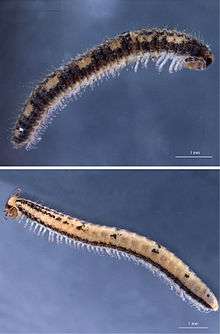 | |
| Two unidentified species from New Zealand | |
| Scientific classification | |
| Kingdom: | Animalia |
| Phylum: | Arthropoda |
| Class: | Diplopoda |
| Subclass: | Chilognatha |
| Infraclass: | Helminthomorpha |
| Order: | Chordeumatida Pocock, 1894 |
| Suborders | |
|
Chordeumatidea | |
| Diversity | |
| c. 50 families, 1200 species | |
| Synonyms | |
|
Ascospermophora Verhoeff, 1900 | |
Description
Chordeumatidans are relatively short-bodied, with only 26-32 body segments behind the head. They range in length from 4–25 mm (0.16–0.98 in). A key feature is the presence of 6 large bristles (setae) on the dorsal surface of each body segment. The first segment (collum) is relatively narrow, giving the appearance of a distinct "neck" in many species. The body tapers towards the rear, and the rearmost tip (telson) contains silk-producing organs (spinnerets). A dorsal groove runs down the length of the body, and some species possess paranota, lateral extensions of the exoskeleton. Paranota are also found in some other millipedes, notably Polydesmida, from which Chordeumatidans can be distinguished by having more than 20 body segments and a dorsal groove. Unlike most other helminthomorph (worm-like) millipedes, Chordeumatidans lack ozopores.[1][2]
Distribution
Chordeumatidans have a large distribution, occurring on all continents except Antarctica. They are present in Madagascar but absent from sub-Saharan Africa and, aside from southern Chile, are largely absent from South America. They occur in the tropics of Central America, Southeast Asia, and Oceania, and as far south as Tasmania, New Zealand, and Chiloé Island, Chile.[3] They are abundant in cold, rocky, mountainous areas of Europe and central Asia, and range northward to Scandinavia, Siberia, and in North America up into Canada and southwest Alaska.[3]
Classification
The Chordeumatida contains approximately 1200 species,[4][5] classified in four suborders and approximately 50 families, although several families contain only one to five genera.[6]
- Suborder Chordeumatidea Pocock 1894
- Superfamily Chordeumatoidea C. L. Koch, 1847
- Chordeumatidae C. L. Koch, 1847
- Speophilosomatidae Takakuwa, 1949
- Suborder Craspedosomatidea Cook, 1895
- Superfamily Anthroleucosomatoidea Verhoeff 1899
- Anthroleucosomatidae Verhoeff 1899
- Haasiidae Hoffman, 1980
- Origmatogonidae Verhoeff 1914
- Vandeleumatidae Mauriès, 1970
- Superfamily Brannerioidea Cook, 1896
- Brachychaeteumatidae Verhoeff, 1910
- Branneriidae Cook, 1896
- Chaemosomatidae Verhoeff, 1913
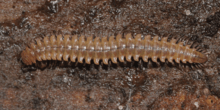 Atractosoma (Craspedosomatidae) from Germany
Atractosoma (Craspedosomatidae) from Germany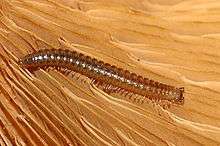 Craspedosoma (Craspedosomatidae) from Belgium
Craspedosoma (Craspedosomatidae) from Belgium - Golovatchiidae Shear, 1992
- Heterolatzeliidae Verhoeff 1899
- Kashmireumatidae Mauriès, 1982
- Macrochaeteumatidae Verhoeff, 1914
- Microlympiidae Shear & Leonard, 2003
- Niponiosomatidae Verhoeff, 1941
- Tingupidae Loomis, 1966
- Trachygonidae Cook, 1896
- Superfamily Cleidogonoidea Cook, 1896
- Biokoviellidae Mrsic, 1992
- Cleidogonidae Cook, 1896
- Entomobielziidae Verhoeff, 1899
- Lusitaniosomatidae Schubart, 1953
- Opisthocheiridae Ribaut, 1913
- Trichopetalidae Verhoeff, 1914
- Superfamily Craspedosomatoidea Gray in Jones, 1843
- Attemsiidae Verhoeff, 1899
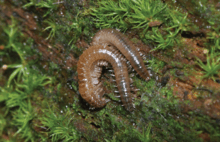 A pair of Haasea (Haaseidae) from Germany. The dorsal groove is visible
A pair of Haasea (Haaseidae) from Germany. The dorsal groove is visible - Craspedosomatidae Gray in Jones, 1843
- Haplobainosomatidae Verhoeff, 1909
- Attemsiidae Verhoeff, 1899
- Superfamily Haaseoidea Attems, 1899
- Haaseidae Attems, 1899
- Superfamily Neoatractosomatoidea Verhoeff, 1901
- Altajellidae Mikhaljova & Golovatch, 2001
- Cyrnosomatidae Mauriès, 2003
- Faginidae Attems, 1926
- Hoffmaneumatidae Golovatch, 1978
- Mastigophorophyllidae Verhoeff, 1899
- Neoactractosomatidae Verhoeff, 1901
- Superfamily Verhoeffioidea Verhoeff, 1899
- Verhoeffiidae Verhoeff, 1899
- Suborder Heterochordeumatidea Shear, 2000
- Superfamily Conotyloidea Cook, 1896
- Adritylidae Shear, 1971
- Conotylidae Cook, 1896
Superfamily Diplomaragnoidea Attems, 1907
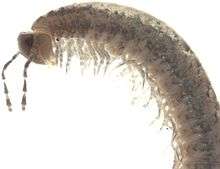
- Diplomaragnidae Attems, 1907
Superfamily Heterochordeumatoidea Pocock, 1894
- Eudigonidae Verhoeff, 1914
- Heterochordeumatidae Pocock, 1894
- Megalotylidae Golovatch, 1978
- Metopidiotrichidae Attems, 1907
- Peterjohnsiidae Mauriès, 1987
Superfamily Pygmaeosomatoidea Carl, 1941
- Lankasomatidae Mauriès 1978
- Pygmaeosomatidae Carl, 1941
- Suborder Striariidea Cook, 1896
- Superfamily Caseyoidea Verhoeff, 1909
- Caseyidae Verhoeff, 1909
- Urochordeumatidae Silvestri, 1909
- Superfamily Striarioidea Bollman, 1893
- Apterouridae Loomis, 1966
- Buotidae Shear, 2009
- Rhiscosomididae Silvestri, 1909
- Striariidae Bollman, 1893
References
- "Millipede Body Organization". Milli-PEET: The class Diplopoda. The Field Museum, Chicago. Retrieved 18 March 2014.
- "Putative apomorphies of millipede clades" (PDF). Milli-PEET: Millipede Systematics. The Field Museum, Chicago, IL. 26 September 2006.
- Shelley, R. M. & Golavatch, S. I. (2011). "Atlas of myriapod biogeography. I. Indigenous ordinal and supra-ordinal distributions in the Diplopoda: Perspectives on taxon origins and ages, and a hypothesis on the origin and early evolution of the class". Insecta Mundi. 158: 1–134.
- Sierwald, Petra; Bond, Jason E. (2007). "Current Status of the Myriapod Class Diplopoda (Millipedes): Taxonomic Diversity and Phylogeny". Annual Review of Entomology. 52 (1): 401–420. doi:10.1146/annurev.ento.52.111805.090210. PMID 17163800.
- Brewer, Michael S.; Sierwald, Petra; Bond, Jason E. (2012). "Millipede Taxonomy after 250 Years: Classification and Taxonomic Practices in a Mega-Diverse yet Understudied Arthropod Group". PLoS ONE. 7 (5): e37240. doi:10.1371/journal.pone.0037240. PMC 3352885. PMID 22615951.
- Shear, W. (2011). "Class Diplopoda de Blainville in Gervais, 1844. In: Zhang, Z.-Q. (Ed.) Animal biodiversity: An outline of higher-level classification and survey of taxonomic richness" (PDF). Zootaxa. 3148: 159–164.
External links


- "Chordeumatida" at the Encyclopedia of Life

- Chordeumatida of Tasmania
- North American Chordeumatida on BugGuide.net